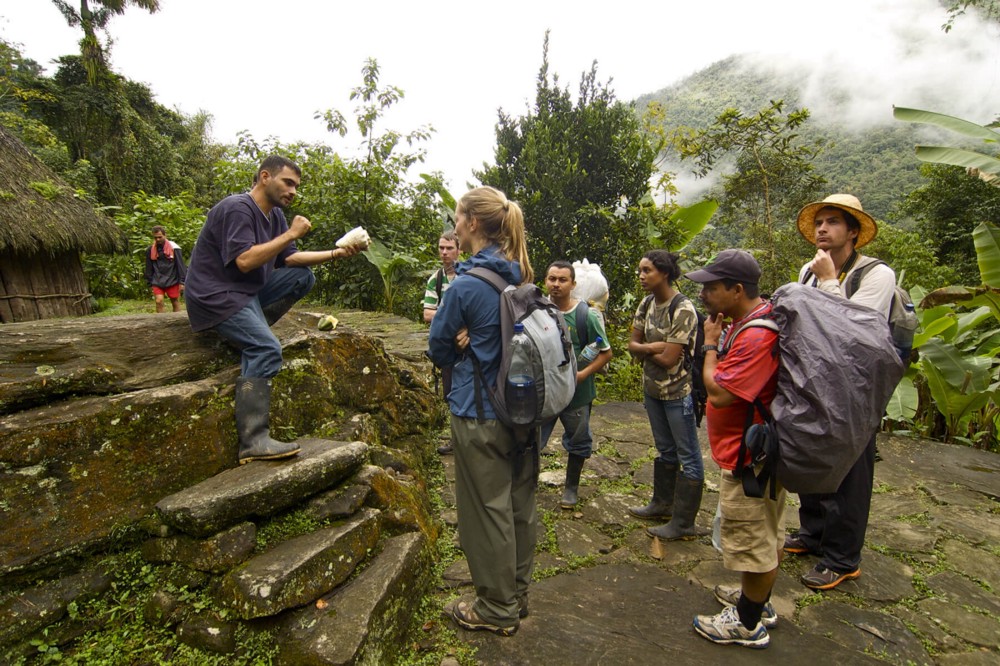
Keeping Colombia megadiverse
By Dr Peter Bickerton
Home to a staggering 10% of all of the species of animals and plants on earth, Colombia’s biodiversity is staggeringly rich and varied. From the high mountains of the Andes descending deep into Amazonian rainforest, to expanses of grassland such as the llanos and páramos, as well as islands in both the Pacific Ocean and Caribbean Sea, Colombia is a treasure trove of life thriving in diverse habitats.
Earlham Institute is at the heart of an international network aiming to preserve, maintain and enrich the biodiversity of this fascinatingly diverse country.
With a land area of 1.142 million kilometres squared, Colombia is by far the smallest of the world’s five most biodiverse countries. Yet, closely following Brazil, Colombia is the second most “megadiverse” country on earth.
Biodiversity to boast about.
Known as “the land of a thousand rhythms,” Colombia’s rich musical heritage actually lays claims to over 1025 distinct folk rhythms drawn from a unique blend of Spanish, native Colombian and African music.
From well known rhythms such as Cumbia and Vallenato to lesser known coastal beats such as Currulao, it’s difficult to match Colombia when it comes to musical genres – and the same can be said for Colombia’s abundant natural diversity.
Colombia leads the world in bird diversity, coming second only to Brazil in the numbers of different amphibians and plants. Helped by its vast and varied landscapes spanning mountains, rivers, rainforests, grasslands and islands, it is no wonder that Colombia boasts such a rich number of different species.
Over half of Colombia is covered in natural forest (an area the size of France), with the country boasting 55,000 species of animals and plants, 3,625 of which are completely unique to Colombia. To put this into perspective, the United Kingdom has fewer than 100 endemic species.
In recent years, Colombia has seen a 16% increase in deforestation due to the combined effects of lumbering, mining, coca planting and drought.
Colombia leads the world in bird diversity, coming second only to Brazil in the numbers of different amphibians and plants. Helped by its vast and varied landscapes spanning mountains, rivers, rainforests, grasslands and islands, it is no wonder that Colombia boasts such a rich number of different species.
Over half of Colombia is covered in natural forest (an area the size of France), with the country boasting 55,000 species of animals and plants, 3,625 of which are completely unique to Colombia. To put this into perspective, the United Kingdom has fewer than 100 endemic species.
The threats to biodiversity.
Amid all of this wonderful biodiversity, the threats to conserving it in the 21st Century are severe. Among them is the armed conflict between the Colombian government and FARC, which, though having signed a ceasefire and later a peace agreement in late 2016, saw internal warfare in the country lasting over five decades.
In light of this historic moment in Colombian history, the new network ‘BRIDGE (Biodiversity, Responsibility, Innovation, Development, Growth, Education) Colombia, founded by our Director of Science Federica Di Palma will connect research institutes in the UK and Colombia with public and private partners to help stimulate economic and social growth around biodiversity.
Although Colombia is the fourth richest country in South America, in rural areas up to 85% of the population live below the international poverty line. In many regions a reprimarisation of the economy is underway, i.e. industry is instead turning back towards primary production methods, such as logging and mining.
Agriculture, too, is a constant threat to native wildlife, with extensive livestock production replacing swathes of natural forest, while the ineradicable demand for illicit substances still pays witness to expansive coca plantations that fuel the international drug trade.
Indeed, in recent years, Colombia has seen a 16% increase in deforestation due to the combined effects of lumbering, mining, coca planting and drought. 20% of their employment is linked to agriculture, while the country’s urban population is expected to increase to over 81% by 2020 — also set to contribute to the alarming rate of deforestation.

Fighting deforestation.
Between 1990 and 2012, the overall forest cover of Colombia dropped from 56.8% to 52.6%, while it is estimated that cocaine production alone could account for a 600,000 hectare loss of forest between 2000 and 2011.
Yet, as with many Amazonian regions, the biggest single driver of deforestation is cattle ranching, which accounts for around half of all forest loss in Colombia.
Mere numbers don’t portray the true tragedy, though, which is that half of all tree species in the Amazon region of South America face extinction.
However, despite a previous lack of investment in environmental policies, Colombia has recently committed to having zero net deforestation by 2020. This, in conjunction with a reduction in military activity in rainforest regions, opens up an interesting possibility for collaboration into how best to promote and preserve the conservation of the country’s vital biodiversity.
Understanding biodiversity.
Along with the threats to agriculture mentioned above, there similarly exists a number of challenges to face when it comes to promoting and maintaining conservation in Colombia.
It is vital that we preserve biodiversity, which ensures we can feed and nourish an expanding global population in a sustainable manner. The genetic diversity present in natural ecosystems is paramount in helping us understand how to better adapt to great agricultural challenges, such as increasing incidences of pests and disease in a rapidly changing climate.
However, due to various factors and despite the best efforts of institutes such as the Instituto de Ciencias Naturales and Instituto Humboldt, there is still a current lack of biodiversity information and appropriate biodiversity valuation in Colombia.
Essentially, we don’t yet know the full extent of biodiversity in Colombia, and we are still to work out the economic value of this biodiversity; especially in relation to better understanding the drivers and projections of biodiversity loss.

Collaboration in biodiversity.
Furthermore, with livestock production employing around 30% of people in rural regions, while promoting local biodiversity, we must ensure that this is in line with the sustainable development of rural economies.
This is where the recent network aims to help. Leading a group of UK institutions working alongside Colombian partners, BRIDGE Colombia aims to help foster innovative development in promoting biodiversity through working closely with Colciencias, the Colombia Bio national programme.
The partnership aims to tackle the aforementioned challenges through fostering common research activities, mobilisation and training of researchers — all while implementing the most modern techniques in conservation science — including next generation genome sequencing and bioinformatics.
A biodiverse future for all to enjoy.
It should be obvious, and it is to many, that we would be wise to preserve the biodiversity of the world above anything else. From the insects that pollinate our crops and the earthworms that churn our soil, to the trees and other plants that act as the lungs of our planet, down to the tiny microorganisms that keep everything circulating in balance — we would be nothing, eat nothing and breathe nothing, without the diversity of life that exists on this planet.
In a country that is home to one in ten of all the species living on earth today, it is clearly apparent that we must preserve its breathtaking array of magnificent life, and this recent agreement represents a great leap in the right direction.
Colombia has some spectacular sights to see, and it’s biodiversity makes it even more special for tourists.

Originally published by Earlham Institute at:
http://www.earlham.ac.uk/keeping-colombia-megadiverse



